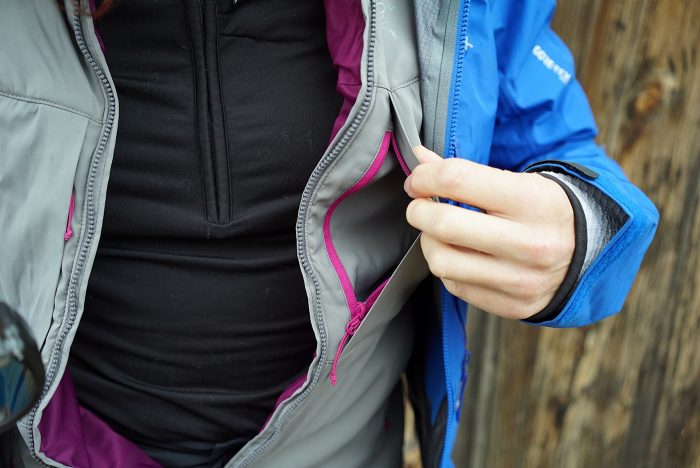Arc’teryx enters the ‘active insulation’ market with a top-notch performer that helps mountain athletes regulate body temps in varying conditions.
Breathability is essential in soft shells used by climbers and backcountry winter adventurers. Without the right balance of warmth and air flow in a mid-layer, athletes get too hot when working hard, and too cold and clammy when belaying or transitioning from skins to skis.
I tested the Arc’teryx Proton AR Hoody over three months on a dozen climbing, split boarding, and cross-country skiing adventures. The conditions brought both frigid and cool temperatures, and sunny and inclement weather.
Arc’teryx’s combination of air-permeable fabrics and lightweight synthetic fill results in a soft shell that works extremely well in most conditions, as to be expected from an expensive, technically advanced jacket.
Arc’teryx Proton AR Hoody Review ($349)

The Proton AR is a lightweight (400g-425g), three-season (fall, winter, spring) soft shell and winter mid layer. It is as warm as a light down puffy, but more versatile for heavy aerobic use.
It’s similar to other high-quality soft shells on the market, such as the slightly heavier (510g) and less expensive ($250) Black Diamond First Light Hoody.
Materials And Performance

The Proton AR performed extremely well in cold temps. Though not fully waterproof, this all-around jacket is more durable, warmer, and more breathable than similar soft shells I own.
The nylon ripstop outer material is abrasion resistant, with a durable water repellent (DWR) finish. I’ve noticed no damage despite using it daily for months, including a two-day solo aid climb of Touchstone Wall in Zion National Park.
While you shouldn’t wear it in a downpour, it does repel light snow and rain.
What makes the Proton AR really shine is the air permeability of the fabrics and insulation. The combination of high-quality Coreloft Continuous Insulation throughout the jacket and Fortius Air 40 outer material allows heat and sweat to escape. You’ll retain more heat with another shell over this, but stay drier without one.

I recently used it split boarding in Rocky Mountain National Park. Temps ranged in the 30s and I put Gore-Tex on for only the first of four laps. The rest of the morning I didn’t sweat too much skinning uphill or get too cold riding downhill to warrant wearing an extra layer.
Other Uses For Proton AR Jacket
Wear a thicker base layer, down vest, and/or add an outer shell, and you can take this mid layer jacket down to the teens.
However, when temps hit the high 40s, the Proton AR is too warm for constant movement. So just stash in your pack for belays or long rappels in the dark.

I recently wore it on a windy, low-40s February evening, climbing relatively difficult terrain on a desert tower. I was plenty warm with the jacket fully zipped and the helmet-compatible hood cinched down tight.
Fit And Fine Details
For me, it’s the little things about a jacket that make the difference. As usual, Arc’teryx harmoniously merges fit, style, and functionality.

This “trim fit” jacket is snug and comfortable, but still loose enough to comfortably wear a layer underneath. Gusseted underarms and articulated elbows ensure complete freedom of movement no matter what you’re doing.
Stretchy chest pockets hold snacks, a headlamp, or even a large smartphone. For much-appreciated extra warmth, the cuffs are stretch-knit and the hand pockets insulated.

A drop-back hem and hem adjusters ensure the Proton AR fits comfortably under a harness.
And it looks good. I’d wear it out on the town with my boyfriend’s parents (after a good washing, as it definitely smells after many days of sweaty workouts).
Downsides
Besides the price, the tiny main zipper pull is annoying. I couldn’t zip the jacket one cold morning while split boarding until I warmed my numb fingers up. I also don’t love the gray color (aka “brushed nickel”), and wish they had flip-flopped it with the vibrant magenta inner layer.
Price, Specs
At $349, the Proton AR Hoody is one of the more expensive technical jackets made for active adventurers. However, if you’re often on the move in the backcountry during the winter months, this will be your jacket of choice. It’s mine. Save your pennies.
The Bottom Line: Arc’teryx Proton AR Hoody

- Where To Wear: Anywhere in the mountains, on desert towers, or on granite walls. Use it during winter, late fall, and early spring. I don’t ice climb, but suspect it would work beautifully as an approach and climbing layer and as an additional belaying layer.
- Who’s It For: Rock, ice, and alpine climbers and backcountry skiers, and snowboarders
- Jacket Maintenance: This jacket doesn’t require special care like a down jacket. Arc’teryx recommends occasional washings to restore the moisture-shedding performance of the DWR surface.
- Important Specs: The women’s weighs 400g/14oz and the men’s 425g/15oz.
- Fit: It fits better and is more flexible than any jacket I’ve ever owned except for the Arc’teryx Atom LT.
- Flaw: It’s the priciest jacket in the “active insulation” category!
- First Impressions: Looks and fits great, is as warm as my lightweight down puffy.
- Available Online here.







